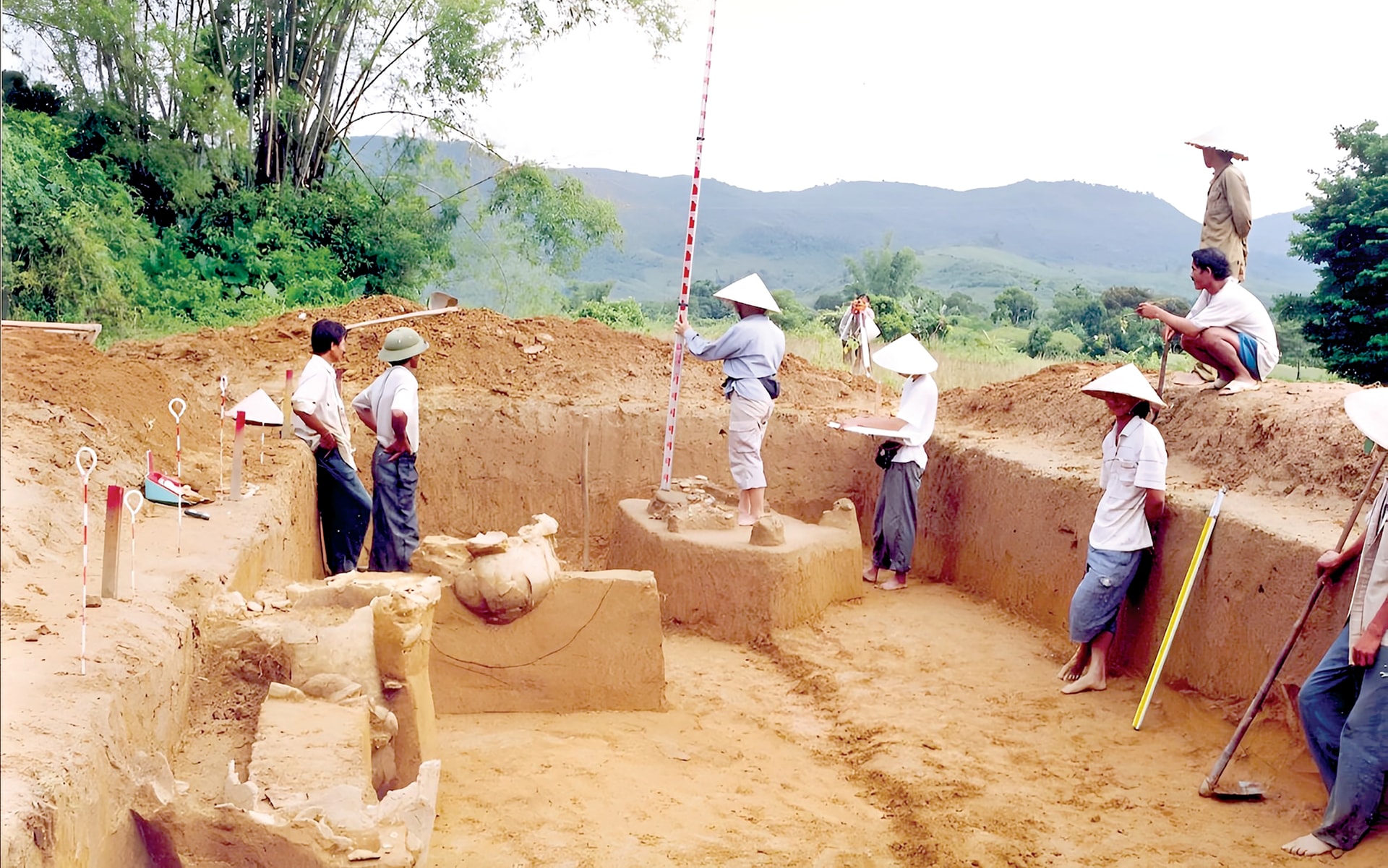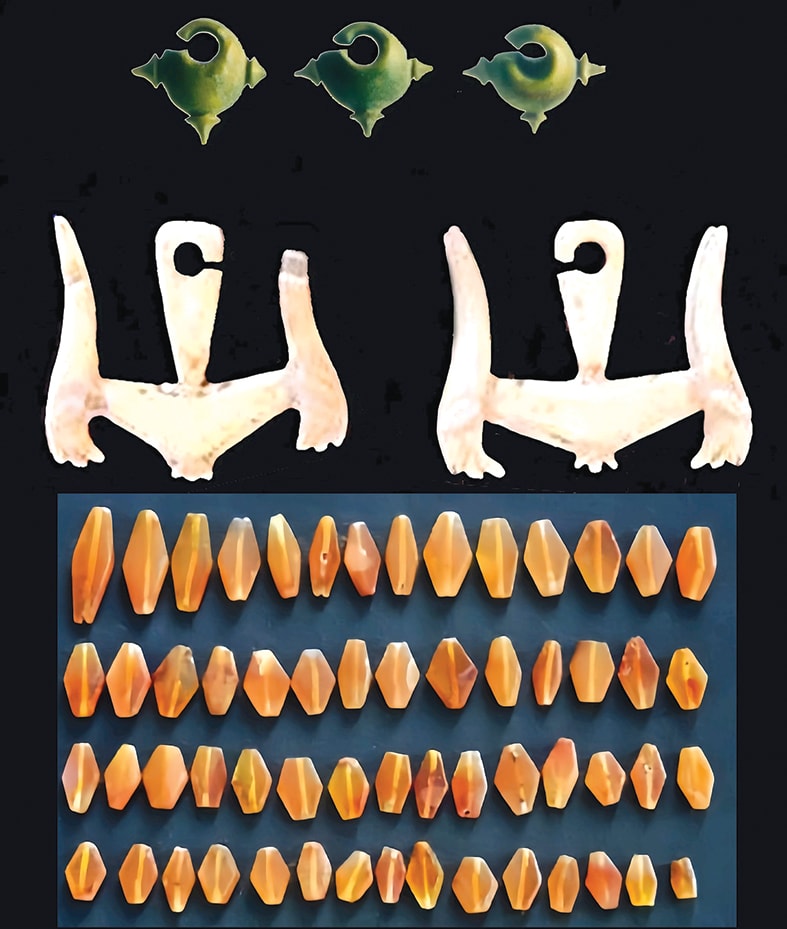
From source to sea
Since ancient times, people in the Quang delta region have brought goods such as gongs, jars, ironware, fish sauce, salt, dried fish, fabrics... by river and road to the upper regions. They bought and sold, exchanged for mountain products such as agarwood, cinnamon, pepper, precious woods...
The Thu Bon and Vu Gia rivers played a very important role on the ancient trade route. From the estuary, coastal areas to the upstream, more than 50 Sa Huynh cultural sites have been discovered on both banks of these two rivers.
In the Sa Huynh relics of Quang region, a large amount of iron tools and weapons, bronze objects, jewelry made of precious stones, gold, agate beads, glass beads... appeared. This shows that Sa Huynh society in Quang region was quite developed. In addition to growing rice and fishing, ancient Sa Huynh people also exploited valuable forest products.
Not to mention, through research on relics found in Sa Huynh relics in Quang region, there are a number of bronze tools and weapons that bear the characteristics of Dong Son culture. From the bud-shaped spear blade at Tam My relic (Tam Xuan), the sugarcane-shaped spear blade, the T-shaped dagger at Phu Hoa relic (Tam Xuan); the balanced axe, the trapezoidal axe, the oblique-bladed axe, the sugarcane-shaped spear tip, the bud-shaped spear tip at Ma Voi mound (Duy Xuyen)...
In particular, there is a Dong Son bronze drum of type II Heger found in Khe Lanh Anh (Song Tra). Among them, the two-headed animal earring appeared in the relics of Dong Son culture in Xuan An ( Nghe An ).
At the same period as Sa Huynh culture and Dong Son culture, Dong Nai culture has the outstanding characteristics of the Southeast region. In this area, there are some Sa Huynh-style burial relics, buried with many iron tools and weapons, jade, agate, glass jewelry... especially the collection of 32 two-headed animal earrings at the two relics of Giong Phet and Giong Ca Vo (Can Gio, Ho Chi Minh City).
The above data proves that thousands of years ago, trade routes were established between ancient residents in the three regions of North - Central - South.
Crossing the ocean
The ancient Sa Huynh people traded with the outside world mainly by waterway; with primitive boats, following the ocean currents of the Pacific and Indian Oceans, they could reach other lands in East Asia and South Asia, at the same time, boats of ancient residents from other regions also docked at some coastal places in Vietnam to exchange and buy necessary products.

Archaeologists have discovered four bronze mirrors from the Western Han Dynasty at the sites of An Bang (Hoi An), Binh Yen (Que Son), Go Dua (Duy Xuyen) and Lai Nghi (Dien Ban).
Along with the relics with Han elements that were found before, such as bronze bowls, some bronze bells from the Western Han period; Ngu Thu coins, Vuong Mang coins, Han-style daggers in Hau Xa (Hoi An), Han-style square patterns on pottery...
In the monograph “Indian Contact” in Sa Huynh culture, Dr. Nguyen Kim Dung stated that agate beads with black and white stripes, purple garnet beads… produced in the Khambat or Arikamada area (India) were present in the Sa Huynh cultural land through trade routes.
In the research work “Sa Huynh Lam Ap - Champa - 5th century BC to 5th century AD (some archaeological issues)”, Professor Lam Thi My Dung said that the beads made of pink agate, agate, crystal, and glass in the Sa Huynh sites in Quang Nam are relics originating from the South Asian region.
Through relics discovered in prehistoric and early historical archaeological sites, it shows that the trade network in Quang region was formed before the Common Era, laying the foundation for the development of Champa port and Hoi An commercial port in the lower Thu Bon River in the following centuries...
Source: https://baodanang.vn/lan-gio-con-duong-giao-thuong-xu-quang-3300868.html


![[Photo] National Assembly Chairman Tran Thanh Man attends the inauguration ceremony of the Memorial Site of National Assembly Standing Committee Chairman Bui Bang Doan](https://vphoto.vietnam.vn/thumb/1200x675/vietnam/resource/IMAGE/2025/9/28/6feba23492d14b03b05445dd9f1dba88)































![[Photo] Soldiers guard the fire and protect the forest](https://vphoto.vietnam.vn/thumb/1200x675/vietnam/resource/IMAGE/2025/9/27/7cab6a2afcf543558a98f4d87e9aaf95)





























































Comment (0)